标签:同步锁 double 产生 不能 技术分享 highlight 超时 show 方法
理论知识部分:
1.程序与进程:
程序是一段静态的代码,它是应用程序执行的蓝本。
进程是程序的一次动态执行,它对应了从代码加载、执行至执行完毕的一个完整过程。
2.多线程
多线程是进程执行过程中产生的多条执行线索。
3.进程:
线程是比进程执行更小的单位。线程不能独立存在,必须存在于进程中,同一进程的各线程间共享进程空间的数据。每个线程有它自身的产生、存在和消亡的过程, 是一个动态的概念。线程创建、销毁和切换的负荷远小于进程,又称 为轻量级进程(lightweight process)。
4.Java实现多线程:
-创建Thread类的子类
-在程序中定义实现Runnable接口的类
5.用Thread类的子类创建线程:
首先需从Thread类派生出一个子类,在该子类中 重写run()方法。
class hand extends Thread { public void run() {……} }
然后用创建该子类的对象
Lefthand left=new Lefthand();
Righthand right=new Righthand();
最后用start()方法启动线程
left.start();
right.start();
6.用Runnable()接口实现线程
首先设计一个实现Runnable接口的类;
然后在类中根据需要重写run方法;
再创建该类对象,以此对象为参数建立Thread 类的对象;
调用Thread类对象的start方法启动线程,将 CPU执行权转交到run方法。
7.线程的终止
调用interrupt()方法;
8.
8、测试线程是否被中断的方法
Java提供了几个用于测试线程是否被中断的方法。
-static boolean interrupted()
– 检测当前线程是否已被中断 ,并重置状态 “interrupted”值为false。
-boolean isInterrupted()
– 检测当前线程是否已被中断 ,不改变状态 “interrupted”值 。
9、线程的状态
-利用各线程的状态变换,可以控制各个线程轮流使用CPU,体现多线程的并行性特征。
-线程有如下7种状态:
New (新建)
Runnable (可运行)
Running(运行)
Blocked (被阻塞)
Waiting (等待)
Timed waiting (计时等待)
Terminated (被终止)
10、新创建线程
-new(新建)
线程对象刚刚创建,还没有启动,此时线程还处于不可运行状态。例如: Thread thread=new Thread(r); 此时线程thread处于新建状态,有了相应的内存空间以及其它资源。
11、可运行线程
- runnable(可运行状态)
此时线程已经启动,处于线程的run()方法之中。
此时的线程可能运行,也可能不运行,只要 CPU一空闲,马上就会运行。
调用线程的start()方法可使线程处于“可运行”状态。例如: thread.start();
12、被阻塞线程和等待线程
- blocked (被阻塞)
一个正在执行的线程因特殊原因,被暂停执行, 进入阻塞状态。
阻塞时线程不能进入队列排队,必须等到引起阻塞的原因消除,才可重新进入排队队列。
引起阻塞的原因很多,不同原因要用不同的方法解除。
-sleep(),wait()是两个常用引起线程阻塞的方法。
13、线程阻塞的三种情况
- 等待阻塞 -- 通过调用线程的wait()方法,让线程等待某工作的完成。
- 同步阻塞 -- 线程在获取synchronized同步锁失败(因为锁被其它线程所占用),它会进入同步阻塞状态。
-其他阻塞 -- 通过调用线程的sleep()或join() 或发出了I/O请求时,线程会进入到阻塞状态。当 sleep()状态超时、join()等待线程终止或者超 时、或者I/O处理完毕时,线程重新转入就绪状态。
14、被终止的线程
Terminated (被终止) 线程被终止的原因有二:
一是run()方法中最后一个语句执行完毕而自然死亡。
二是因为一个没有捕获的异常终止了run方法而意外死亡。
可以调用线程的 stop 方 法 杀 死 一 个 线 程(thread.stop();),但是,stop方法已过时, 不要在自己的代码中调用它。
15、多线程调度
-Java 的线程调度采用优先级策略:
优先级高的先执行,优先级低的后执行;
多线程系统会自动为每个线程分配一个优先级,缺省时,继承其父类的优先级;
任务紧急的线程,其优先级较高;
同优先级的线程按“先进先出”的队列原则;
实验部分:
实验1:
测试程序1:
package synch;
/**
* 这个程序展示了多线程如何安全地访问数据结构。
* @version 1.31 2015-06-21
* @author Cay Horstmann
*/
public class SynchBankTest
{
public static final int NACCOUNTS = 100;
public static final double INITIAL_BALANCE = 1000;
public static final double MAX_AMOUNT = 1000;
public static final int DELAY = 10;
public static void main(String[] args)
{
Bank bank = new Bank(NACCOUNTS, INITIAL_BALANCE);
for (int i = 0; i < NACCOUNTS; i++)
{
int fromAccount = i;
Runnable r = () -> {
try
{
while (true)
{
int toAccount = (int) (bank.size() * Math.random());
double amount = MAX_AMOUNT * Math.random();
bank.transfer(fromAccount, toAccount, amount);
Thread.sleep((int) (DELAY * Math.random()));
}
}
catch (InterruptedException e)
{
}
};
Thread t = new Thread(r);
t.start();
}
}
}
package synch;
import java.util.*;
import java.util.concurrent.locks.*;
/**
* 具有许多银行帐户的银行,使用锁序列化访问。
* @version 1.30 2004-08-01
* @author Cay Horstmann
*/
public class Bank
{
private final double[] accounts;
private Lock bankLock;//锁对象
private Condition sufficientFunds;
/**
* 构建银行。
* @param n账户数量
* @param 每个帐户的初始余额
*/
public Bank(int n, double initialBalance)
{
accounts = new double[n];
Arrays.fill(accounts, initialBalance);
bankLock = new ReentrantLock();
sufficientFunds = bankLock.newCondition();
}
/**
* 把钱从一个账户转到另一个账户,再从一个账户转到另一个账户,再从另一个账户转到另一个账户
* @param from the account to transfer from
* @param to the account to transfer to
* @param amount the amount to transfer
*/
public void transfer(int from, int to, double amount) throws InterruptedException
{
bankLock.lock();
try
{//锁对象的引用条件对象
while (accounts[from] < amount)
sufficientFunds.await();
System.out.print(Thread.currentThread());//打印出线程号
accounts[from] -= amount;
System.out.printf(" %10.2f from %d to %d", amount, from, to);
accounts[to] += amount;
System.out.printf(" Total Balance: %10.2f%n", getTotalBalance());
sufficientFunds.signalAll();
}
finally
{
bankLock.unlock();
}
}
/**
* 获取所有帐户余额的总和。
* @return 总平衡
*/
public double getTotalBalance()
{
bankLock.lock();//加锁
try
{
double sum = 0;
for (double a : accounts)
sum += a;
return sum;
}
finally
{
bankLock.unlock();//解锁
}
}
/**
* 获取银行中的帐户数量。
* @return 账户数量
*/
public int size()
{
return accounts.length;
}
}
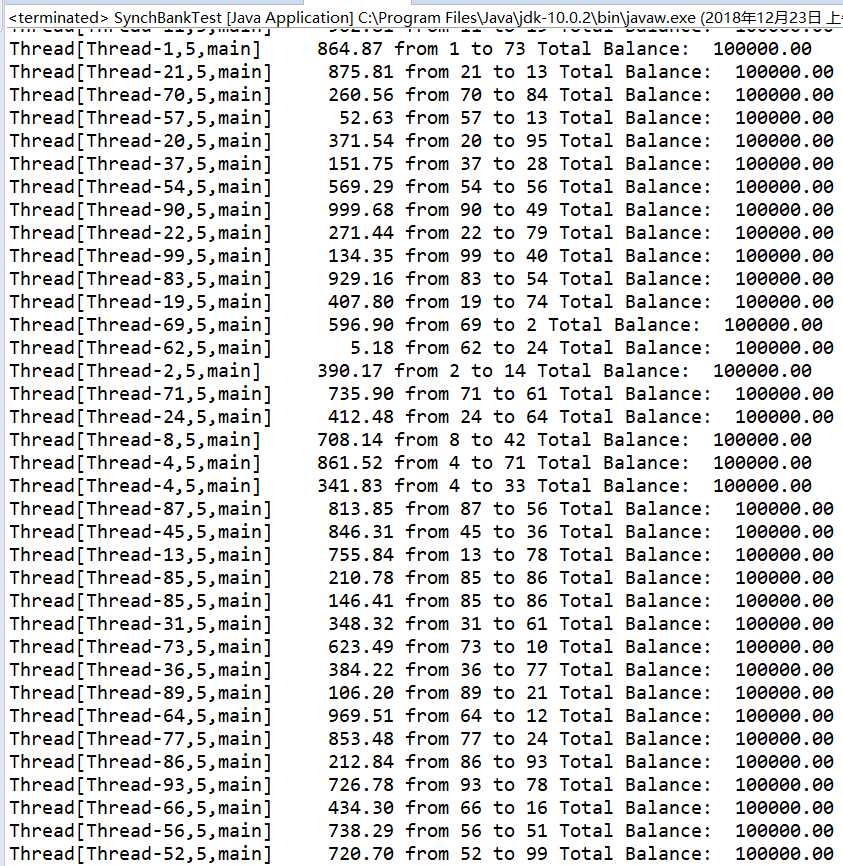
package synch2;
import java.util.*;
/**
* A bank with a number of bank accounts that uses synchronization primitives.
* @version 1.30 2004-08-01
* @author Cay Horstmann
*/
public class Bank
{
private final double[] accounts;
/**
* Constructs the bank.
* @param n the number of accounts
* @param initialBalance the initial balance for each account
*/
public Bank(int n, double initialBalance)
{
accounts = new double[n];
Arrays.fill(accounts, initialBalance);
}
/**
* Transfers money from one account to another.
* @param from the account to transfer from
* @param to the account to transfer to
* @param amount the amount to transfer
*/
public synchronized void transfer(int from, int to, double amount) throws InterruptedException
{
while (accounts[from] < amount)
wait();
System.out.print(Thread.currentThread());
accounts[from] -= amount;
System.out.printf(" %10.2f from %d to %d", amount, from, to);
accounts[to] += amount;
System.out.printf(" Total Balance: %10.2f%n", getTotalBalance());
notifyAll();
}
/**
* Gets the sum of all account balances.
* @return the total balance
*/
public synchronized double getTotalBalance()
{
double sum = 0;
for (double a : accounts)
sum += a;
return sum;
}
/**
* Gets the number of accounts in the bank.
* @return the number of accounts
*/
public int size()
{
return accounts.length;
}
}
package synch2;
/**
* This program shows how multiple threads can safely access a data structure,
* using synchronized methods.
* @version 1.31 2015-06-21
* @author Cay Horstmann
*/
public class SynchBankTest2
{
public static final int NACCOUNTS = 100;
public static final double INITIAL_BALANCE = 1000;
public static final double MAX_AMOUNT = 1000;
public static final int DELAY = 10;
public static void main(String[] args)
{
Bank bank = new Bank(NACCOUNTS, INITIAL_BALANCE);
for (int i = 0; i < NACCOUNTS; i++)
{
int fromAccount = i;
Runnable r = () -> {
try
{
while (true)
{
int toAccount = (int) (bank.size() * Math.random());
double amount = MAX_AMOUNT * Math.random();
bank.transfer(fromAccount, toAccount, amount);
Thread.sleep((int) (DELAY * Math.random()));
}
}
catch (InterruptedException e)
{
}
};
Thread t = new Thread(r);
t.start();
}
}
}
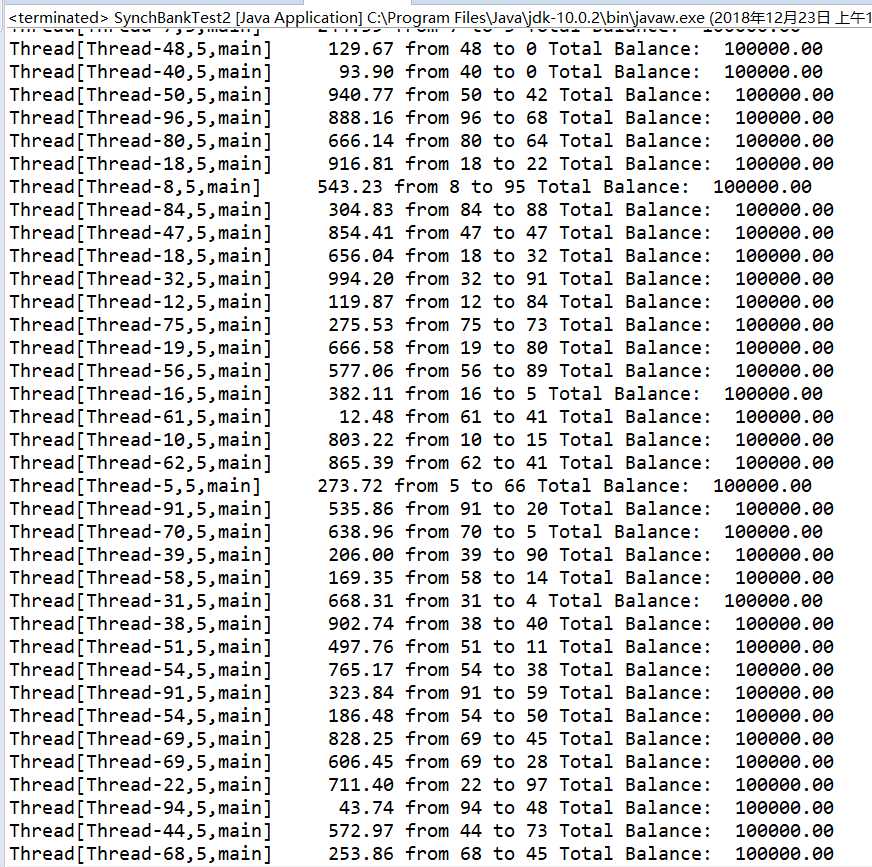
测试程序3:
class Cbank
{
private static int s=2000;
public static void sub(int m)
{
int temp=s;
temp=temp-m;
try {
Thread.sleep((int)(1000*Math.random()));
}
catch (InterruptedException e) { }
s=temp;
System.out.println("s="+s);
}
}
class Customer extends Thread
{
public void run()
{
for( int i=1; i<=4; i++)
Cbank.sub(100);
}
}
public class Thread3
{
public static void main(String args[])
{
Customer customer1 = new Customer();
Customer customer2 = new Customer();
customer1.start();
customer2.start();
}
}
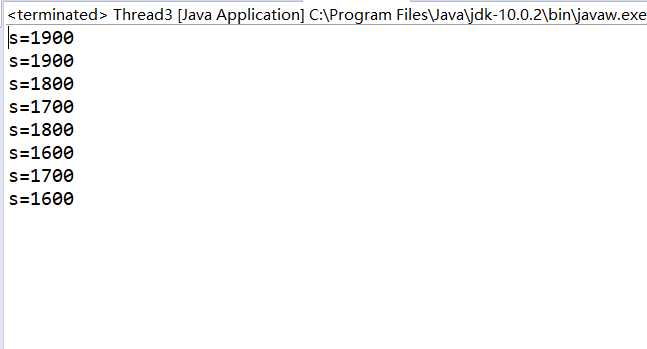
修改代码
package lll;
class Cbank
{
private static int s=2000;
public synchronized static void sub(int m)
{
int temp=s;
temp=temp-m;
try {
Thread.sleep((int)(1000*Math.random()));
}
catch (InterruptedException e) { }
s=temp;
System.out.println("s="+s);
}
}
class Customer extends Thread
{
public void run()
{
for( int i=1; i<=4; i++)
Cbank.sub(100);
}
}
public class Thread3
{
public static void main(String args[])
{
Customer customer1 = new Customer();
Customer customer2 = new Customer();
customer1.start();
customer2.start();
}
}
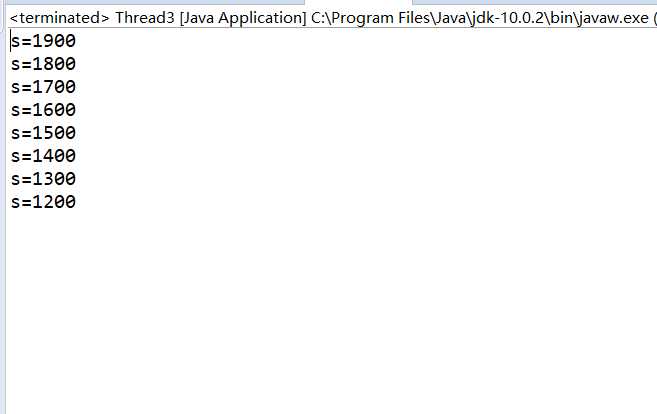
实验2 编程练习
package lll;
public class Demo {
public static void main(String[] args) {
Runnable runnable = new MyThread();
new Thread(runnable).start();
new Thread(runnable).start();
new Thread(runnable).start();
}
public static class MyThread implements Runnable{
private int tickets=10;
public void run() {
while(tickets>0){
System.out.println(Thread.currentThread().getName() + "窗口售:第" + tickets-- + "张票");
}
}
}
}
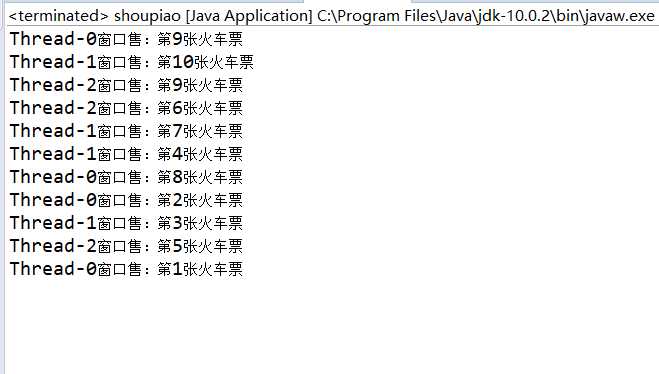
实验总结:
本周我们继续学习了同步线程的相关知识,了解了并发多线程的两种解决方法,一种是锁对象,还有一种是synchronized关键字。还有wait()、notify 和notifyAll()方法。
这学期Java我们已经学到了最后一章,在这将近一个学期的学习中感谢有老师悉心的传授我知识,还有告诉了我们很多的不论是Java学习还是其他方面的道理。还有学长每次不厌其烦的为我们演示代码,给我们分享自己的经验,牺牲了很多自己的时间。
在以后的学习力我会继续完善在这门语言学习中我的不足,也会铭记老师的教诲,不会学完之后就忘记,而是学会使用这门语言解决以后学习中的问题。
在这里对老师和学长再次表示真挚的感谢。
孔维滢 20171010110《面向对象程序设计(java)》第十七周学习总结
标签:同步锁 double 产生 不能 技术分享 highlight 超时 show 方法
原文地址:https://www.cnblogs.com/Weiron/p/10163823.html